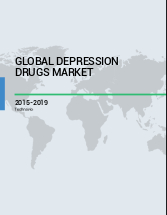

Enjoy complimentary customisation on priority with our Enterprise License!
01. Executive Summary
02. List of Abbreviations
03. Scope of the Report
03.1 Market overview
03.2 Product offerings
04. Product Profiles
04.1.1 Celexa
04.1.2 Fetzima
04.1.3 Lexapro
04.1.4 Viibryd
04.1.5 Cymbalta
04.1.6 Prozac
04.1.7 Symbyax
04.1.8 Paxil
04.1.9 Wellbutrin
04.1.10 Abilify
04.1.11 Effexor
04.1.12 Pristiq
04.1.13 Zoloft
05. Market Research Methodology
05.1 Market Research Process
05.2 Research Methodology
06. Introduction
07. Disorder Overview
07.1 Types of depression
07.1.1 Major depressive disorder
07.1.2 Persistent depressive disorder
07.1.3 Psychotic depression
07.1.4 Postpartum depression
07.1.5 Seasonal affective disorder
07.1.6 Bipolar disorder
07.2 Etiology
07.3 Epidemiology
07.3.1 Bipolar disorder among adults
07.3.2 Dysthymic disorder among adults
07.3.3 Major depression among adults
07.3.4 Major depression among adolescents
07.4 Treatment and management
07.5 Economic burden
08. Market Landscape
08.1 Market overview
08.2 Market size and forecast
08.3 Depression drugs market in US 2014-2019
08.3.1 Market size and forecast
08.4 Five forces analysis
09. Market Segmentation by Mechanism of Action
10. Geographical Segmentation
10.1 Segmentation of global depression drugs market by geography 2014
11. Pipeline Portfolio
11.1 Key information on late-stage pipeline molecules
11.1.1 Brexpiprazole
11.1.2 ALKS 5461
11.1.3 Cariprazine
11.1.4 TGFK07AD
12. Buying Criteria
13. Market Growth Drivers
14. Drivers and their Impact
15. Market Challenges
16. Impact of Drivers and Challenges
17. Market Trends
18. Trends and their Impact
19. Vendor Landscape
19.1 Competitive scenario
19.1.1 Key news
19.1.2 Mergers and acquisitions
19.2 Market share analysis 2014
19.2.1 Competitive assessment of top drugs used for treating depression
19.2.2 Bristol-Myers Squibb
19.2.3 Eli Lilly
19.2.4 Pfizer
19.2.5 GlaxoSmithKline
19.2.6 Actavis
19.3 Other and future prominent vendors
20. Key Vendor Analysis
20.1 Actavis
20.1.1 Key Facts
20.1.2 Business Overview
20.1.3 Business Segmentation
20.1.4 Business Segmentation by Revenue 2012 and 2013
20.1.5 Geographical segmentation by Sales 2013
20.1.6 Business Strategy
20.1.7 Recent Developments
20.1.8 SWOT Analysis
20.2 Bristol-Myers Squibb
20.2.1 Key Facts
20.2.2 Business Overview
20.2.3 Key Product Offerings
20.2.4 Revenue by Geography
20.2.5 Business Strategy
20.2.6 Key Information
20.2.7 SWOT Analysis
20.3 Eli Lilly
20.3.1 Key Facts
20.3.2 Business Overview
20.3.3 Business Segmentation by Revenue
20.3.4 Sales by Geography
20.3.5 Business Strategy
20.3.6 Key Information
20.3.7 SWOT Analysis
20.4 GlaxoSmithKline
20.4.1 Key facts
20.4.2 Business overview
20.4.3 Business segmentation by revenue 2014
20.4.4 Business segmentation by revenue 2013 and 2014
20.4.5 Geographical segmentation by revenue 2014
20.4.6 Business strategy
20.4.7 Recent developments
20.4.8 SWOT analysis
20.5 Pfizer
20.5.1 Key facts
20.5.2 Business overview
20.5.3 Business segmentation by revenue 2014
20.5.4 Business segmentation by revenue 2013 and 2014
20.5.5 Geographical segmentation by revenue 2014
20.5.6 Business strategy
20.5.7 Key developments
20.5.8 SWOT analysis
21. Other Reports in this Series
Research Framework
Technavio presents a detailed picture of the market by way of study, synthesis, and summation of data from multiple sources. The analysts have presented the various facets of the market with a particular focus on identifying the key industry influencers. The data thus presented is comprehensive, reliable, and the result of extensive research, both primary and secondary.

Primary sources
Secondary sources


Data Synthesis
Data Validation


Qualitative
Quantitative
Get lifetime access to our
Technavio Insights
Quick Report Overview:
Quick Report Overview:
Cookie Policy
The Site uses cookies to record users' preferences in relation to the functionality of accessibility. We, our Affiliates, and our Vendors may store and access cookies on a device, and process personal data including unique identifiers sent by a device, to personalise content, tailor, and report on advertising and to analyse our traffic. By clicking “I’m fine with this”, you are allowing the use of these cookies. Please refer to the help guide of your browser for further information on cookies, including how to disable them. Review our Privacy & Cookie Notice.